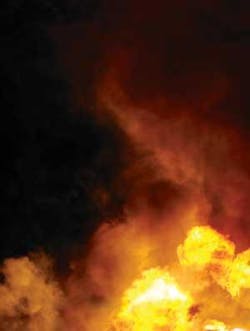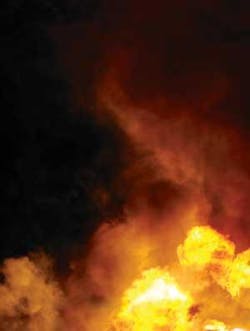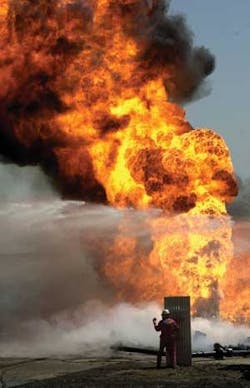Insurance coverage disputes arising from well blowouts
PART 2 OF 2 PARTS
EDITOR’S NOTE: In this final installment in a two-part series, Edward O’Gorman, who handles trials and appeals of insurance coverage and construction cases, examines disputes involving well blowouts. The views expressed are his and are not necessarily those of his firm, its clients, or Oil & Gas Financial Journal.
Advances in drilling operations have made possible exploration and the extraction of oil and gas from remote areas and severe clilmates. However, well blowouts with potentially catastrophic damages remain a risk.
Edward J. O’Gorman Wilson, Elser, Moskowitz, Edelman & Dicker White Plains, NY
While an insurance policy may provide coverage for pollution cleanups, it may also exclude coverage for well control costs. Where that occurs, is a pollution cleanup excluded when it is part of bringing a well under control, and if so, is pollution coverage illusory in that instance?
In Tristar Exploration v. Mid-Continent (Cas., 2007 Tex. App. Lexis 4953), when an insured attempted to re-enter a well, the “well pressure encountered exceeded the wellhead pressure,” causing a blowout. A contractor was immediately retained by the insured to bring the well under control. Insurance coverage included the “clean-up costs incurred to curtail or prevent a pollution incident that poses an imminent and substantial danger of bodily injury, property damage or environmental damage …”
Excluded from coverage was: “Any cost or expense incurred … in connection with controlling or bringing under control any oil, gas or water well.”
The insurer denied coverage for the contractor’s costs, claiming the costs were incurred in bringing the well under control. The insured responded, “it is not possible to envision the act of curtailing or preventing a pollution incident from an oil and gas well that would not involve controlling or bringing under control the well.”
The court disagreed that the well control exclusion eviscerated pollution coverage. Finding the policy language unambiguous, it held damages related to well control were excluded from coverage.
Does the holding result in illusory pollution coverage? Where a well blowout results in a discharge of oil or gas into the environment, insureds must attempt to distinguish environmental remediation from well control measures. While the costs of extinguishing a platform fire may be viewed as well control costs, remediation of surrounding third-party property damaged by pollutants discharged from a well would likely not be control costs.
CGL exclusions
CGL insurance provides contractors coverage for third-party property damage resulting from faulty workmanship or use of defective products. However, coverage is contingent upon fortuitous damages. Where there is no risk of damages not occurring, there is no occurrence and no coverage.
Photo courtesy of Boots & Coots International Well Control Inc.
In Meridian Oil v. Hartford (27 F.3d 150), drilling operations damaged a fresh water aquifer. Finding the insurer had no duty to defend or indemnify because there was no occurrence, the court relied upon the resulting inevitable damage of the insured’s drilling method:
An operator knows when the drill stem goes through a fresh water aquifer and knows that if no surface casing or string of pipe is set in place to protect the water from drilling muds, fluids and subsequent contaminants, the fresh water will be polluted. The operator knows that the pollution will continue if no plug or cemented pipe prevent migration of fluids up and down the well bore.
Insureds argue CGL coverage should not be limited to third-party property damage where a contractor’s faulty workmanship resulted in unexpected damages. Where damages are unexpected, coverage should be extended to replacing or repairing the faulty workmanship.
If a contractor’s installation of windows was negligently performed, or performed by a sub-contractor, the CGL policy should provide coverage to replace the windows. Many courts have denied coverage because of an insured’s control over work methods and choice of materials. Where there is such control, damages are not the result of an accident.
There are policies allowing coverage to a contractor where damages resulted from a subcontractor’s actions. Recently, some states’ highest courts, including the Texas Supreme Court in a 2007 decision, Lamar Homes v. Mid-Continent (Cas., 239 S.W.3d 236), have held there is coverage for contractors where resulting damages of faulty workmanship were unintended. The Lamar Homes case involved damages to new homes from foundation defects. Contractors’ claims for repairing or replacing faulty work may be covered where damages were unexpected.
Courts assessing coverage for repair or replacement of insureds’ faulty work when drilling wells, have denied coverage for re-drilling costs. In Schneider Equipment v. Travelers (2006 U.S. Dist. Lexis 71725), an insured re-drilled a well that had collapsed and installed a screen assembly and filter pack. An insured’s employees damaged the screen, resulting in a “partially obstructed water passage up the screen.” Where the damaged screen prevented the well from producing the anticipated volume of water, another well had to be drilled. The Oregon court denied coverage for the costs of drilling another well where damage was limited to the insured’s work, i.e., the well screen.
In Advent Drilling v. Bituminous (Cas., 1990 Ohio App. Lexis 2487), an insured entered into a contract to drill six wells. While drilling one of the wells, a fire occurred in the well hole, causing a cave-in and destroying the insured’s equipment. The cave-in required a second hole to be drilled and the insured sought to recover for the costs of drilling and the equipment. However, where damages resulted from the insured’s faulty workmanship and third parties sustained no damage, coverage was denied.
Courts often use the phrase, “CGL coverage is not a construction bond,” in denying coverage for claims of repair and replacement of faulty work. While a construction bond provides first-party coverage, CGL coverage is often limited to third-party property damage.
While CGL coverage may not encompass repair/replacement costs from faulty work, coverage existed for a negligent product recommendation. In Petroleum Rental Tools v. Hal Oil (701 So.2d 219), the insured negligently recommended a specific type of casing for a well, failed to explain the risks of the casing, and failed to advise as to the possibilities and uses of electronic inspection of the casing.”
Photo courtesy of Boots & Coots International Well Control Inc.
While the recommended casing caused the well to fail, the insured did not install the casing. Failing to warn of product dangers or deficiencies was not faulty workmanship. Where the insured was “neither performing work on the … well which failed, nor was restoration … of the well made necessary by reason” of an insured’s faulty workmanship, there was coverage.
Third-part damage
Where CGL insurance provides coverage for third-party damage and usually provides no coverage for insureds’ replacement/repair costs, policy disputes have arisen as to what constitutes third-party property. Underwriters at Lloyd’s v. OSCA Inc. (2006 US App. Lexis 9717), arose out of an oil and gas blowout on a fixed platform in the Gulf of Mexico.
A subcontractor was attempting to set up a bridge plug using coiled tubing to run the plug into the well. (A bridge plug is a downhole tube designed to isolate a lower zone while testing an upper section.) The contract required back pressure valves to be included in the coiled tubing assembly. (A back pressure valve is designed to close in the event of a sudden increase in pressure.) No back pressure valves were used by the subcontractor.
On a third attempt to set the bridge plug, tool string attached to the tubing stopped approximately 915 feet inside the well as if it had struck something. The coiled tubing buckled and parted, resulting in gas flowing to the well surface. An “uncontrolled blowout” lasting several days damaged the well and drilling platform.
The insurer denied coverage for the re-drilling costs, platform repairs and relief well costs, based upon an exclusion denying coverage for damage to “that particular part of real property or fixtures on which any insured … are performing operations.” The insurer argued the well and platform were property where the insured was working.
The insured responded that the exclusion was limited to the portion of the platform where it was actually working, i.e., casing at the top of the well and the portion of the platform “immediately surrounding the casing.” The exclusion did not apply to the remainder of the damaged platform or redrilling costs. The court agreed the exclusion was confined to areas of the platform where the insured “was actually working.”
Third-party damage was at issue involving an exclusion for damage to property in the insured’s care, custody and control. In Bituminous Cas. v. Fulkerson (571 N.E.2d 256), an Illinois decision, the insured was hired to “set a Guiberson packer” in an oil well being constructed. (The court wrote, “a packer is essentially a cylindrical plug which can be inserted into the casing which lines oil well bores. Its purpose is to enable sections of the well to be isolated so that work can be performed on limited or specific areas of the oil-bearing formation.)
The packer installed by the contractor resulted in blocking the well, and the well was abandoned. Damages were sought for the costs of re-drilling a second well, costs expended in retrieving the packer, and loss of oil production resulting from having to drill a second well. The exclusion provided:
Insurance did not apply to damage to property in the care, custody or control of the insured or as to which is for any purpose exercising physical control.
While the insurer argued the packer was in the insured’s control when it was negligently installed in the well, the court found the packer was not the damaged property. Rather, the entire well was damaged and the insured was not in control of the well. Where the insured exercised no control over the damaged well, the exclusion did not apply.
Illinois precedent held property was in an insured’s care, custody or control “when it is in the possessory control of the insured at the time of the loss and is a necessary element of the work performed.” Where the insured’s sole obligation was to “set the packer in the well,” the “mere performance of such work in the wellbore was insufficient to trigger the exclusion.” (“… complaint contains no … allegations from which one could reasonably infer that the process of setting the packer necessitated that [the contractor] assert any sort of care, custody or control over that well.”)
‘Occurrence’ – space and time
Premium costs are reduced where insureds retain a portion of risk through a deductible or self-insured retention (SIR). The amount of deductible/SIR must be satisfied before insurance coverage is triggered. Where an accident generates multiple claims, is the deductible/SIR paid for each claim, or is only one deductible/SIR paid, no matter the amount of claims? Where an insured had a $25,000 deductible, an accident resulted in four claims and each claim exceeded $25,000. Would the insured pay $100,000 or $25,000, before its insurer’s policy was triggered?
Devillier v. Alpine Exploration (946 So. 2d 738), a 2006 Louisiana decision, arose out of a hydrocarbon blowout resulting in multiple lawsuits for personal injuries and property damages. The insured argued there was only one occurrence and therefore, once the deductible was exhausted from either one or more claims, its insurance coverage was triggered. The policy language provided:
The deductible amount … is applicable to each “claim” and each “pollution condition”, applies once to each “claim” and each “pollution condition” …
Along with the above language, the court reviewed the policy’s contractors pollution liability coverage endorsement, which used the phrase, “claim or claims made.” The court reasoned that if the deductible language referred to a single claim, as the insurer argued, then the addition of “or claims” language in the endorsement was meaningless.
Finding the policy “treated claim or claims as the same,” “per claim” was the same as “per claims.” Finding the policy language to be ambiguous, the court applied the definition favoring the insured’s interests. The insured had to pay only one deductible before its insurance coverage was triggered.
There appears to be a trend to define “occurrence” by space and time. Where an occurrence results in multiple claims being made at or near the same time and from the same geographical area, only one SIR/deductible is paid.
In International Flavors & Fragrances, Inc. v. Royal Ins. (844 N.Y.S.2d 257), a New York decision, the insured’s use of butter containing “volatile organic compounds” in its microwave popcorn resulted in 30 lawsuits.
The insured’s SIR was $100,000 or $50,000 for each occurrence. The insured argued there was a single occurrence, and thus, its exposure was confined to $50,000, rather than $100,000. However, where the plaintiffs were exposed to the “compounds” at different times, and different durations, there were separate occurrences. The insured’s SIR applied to each claim. Pursuant to a space and time analysis, damages from a blowout will likely constitute one occurrence, triggering only one deductible/SIR.
Conclusion
Where various types of property damage may result from well blowouts, policy exclusions and interpretations of disputed policy language may limit or deny insurance coverage in certain instances. Potential coverage limitations may not be readily evident when insureds are unaware of possible damages of drilling operations.
Has an insured reviewed a geologic map in determining whether drilling operations are confined to a single formation? Has an expert inspected a well after a blowout to determine whether production can safely continue via a relief well? Does policy language indicate whether homeowners’ claims from a natural gas blowout require a deductible to be applied to each claim?
Awareness of potential damages provides insureds and insurers knowledge of the percentage of risk being assumed in specific instances. The more risk managers understand the types and nature of potential damages from drilling operations, the more effective is a company’s risk management plan.
About the author
Edward J. O’Gorman [[email protected]] is a partner with the law firm, Wilson, Elser, Moskowitz, Edelman & Dicker. He has written numerous articles on the subject of risk management and insurance coverage and is the author of two books, Intellectual property Insurance Coverage Disputes, a three-volume 50-state analysis, and Pollution Coverage Issues, a two-volume 50-state analysis, the latter published by the International Risk Management Institute.




